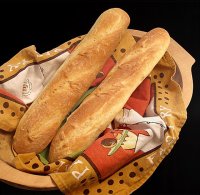 Bread bakers often talk about the percent hydration of dough or water Baker's %; that is the weight of the liquids relative to the weight of the flour. Hydration is one of the most important factors in mixing, and in the final appearance of the product since the hydration level helps the baker predict the texture of the crumb. NOTE: Liquid ingredients also include water, milk, alcohol, and juice. It is also important to take into consideration the type of flour used in the formula. Different millers have different gluten levels in their flour, and if a different type of flour is used, the water baker’s % will likely change. For example, most dry dough such as bagels and pretzels are 50-57 baker’s % water, while most bread is 58-65 baker’s % water.
Bread bakers often talk about the percent hydration of dough or water Baker's %; that is the weight of the liquids relative to the weight of the flour. Hydration is one of the most important factors in mixing, and in the final appearance of the product since the hydration level helps the baker predict the texture of the crumb. NOTE: Liquid ingredients also include water, milk, alcohol, and juice. It is also important to take into consideration the type of flour used in the formula. Different millers have different gluten levels in their flour, and if a different type of flour is used, the water baker’s % will likely change. For example, most dry dough such as bagels and pretzels are 50-57 baker’s % water, while most bread is 58-65 baker’s % water.
To calculate the hydration level of a conventional recipe, first weigh the flour and water or other liquid. Divide the weight of the water by the weight of the flour and then multiply the result by 100. For example, a recipe containing 1 1/4 cups of water (10 ounces) and 3 cups of all-purpose flour (15 ounces) will have a 67 percent (10/15 x 100 = 67) hydration level, indicating a moderately airy crumb.
The percent hydration of dough can also be calculated according to its Baker's Percentage.
| INGREDIENT | PERCENTAGE |
| Flour | 100 |
| Water | 60 |
| Yeast | 2 |
| Salt | 2 |
Hydration affects the process of bread building and the nature of the final result. Generally speaking, the more water in the dough, the more open the final bread's crumb. Bread can also be classified according to three categories based on hydration: stiff, standard or rustic.
|
DOUGH TEXTURE |
% HYDRATION |
BREAD TYPE AND CRUMB |
|
|
Stiff: |
50 to 57 |
Yields dense crumb in breads such as bagels, pretzels
Bagels (50 to 57% hydration) are one of the least hydrated doughs and are extremely stiff. This means that they need a ton of kneading to get all the flour incorporated and gluten developed; it also means that they are not sticky at all in dough form. |
|
|
Standard: |
58 to 65 |
Yields a denser, closed crumb, in breads such as sandwich bread, rolls, French and other European breads
Many formulas, such as white sandwich bread, French bread, and challah, use around 57 to 65% hydration. The dough starts to be a bit more tacky, but also more extensible. These doughs can hold their shape well, but also allow for a greater volume in proofing (rising). |
|
|
Rustic: |
65 to 80 or more |
Yields an airy crumb and large, irregular holes, in breads such as ciabatta, focaccia, pizza
On the higher end of the spectrum you have breads like focaccia and ciabatta, which could be 65 to 80% or more hydrated. These doughs are extremely sticky. Kneading does not usually work on these doughs, and instead techniques used are turning (folding) or just letting the dough develop the gluten over a long period of time on its own (no kneading). We use this technique with the Parmesan, Bacon and Walnut Topped Whole Wheat Focaccia Bread Recipe. These doughs need careful shaping. They might need a bit more bake time than usual prevent the inside from being gummy. |
|
NOTE: Different types of flour absorb water differently because of their gluten protein percents. You may need to adjust dough consistencies; hydration with one flour at 75% may need to be adjusted to 73% or 77% when using a different brand or type.


